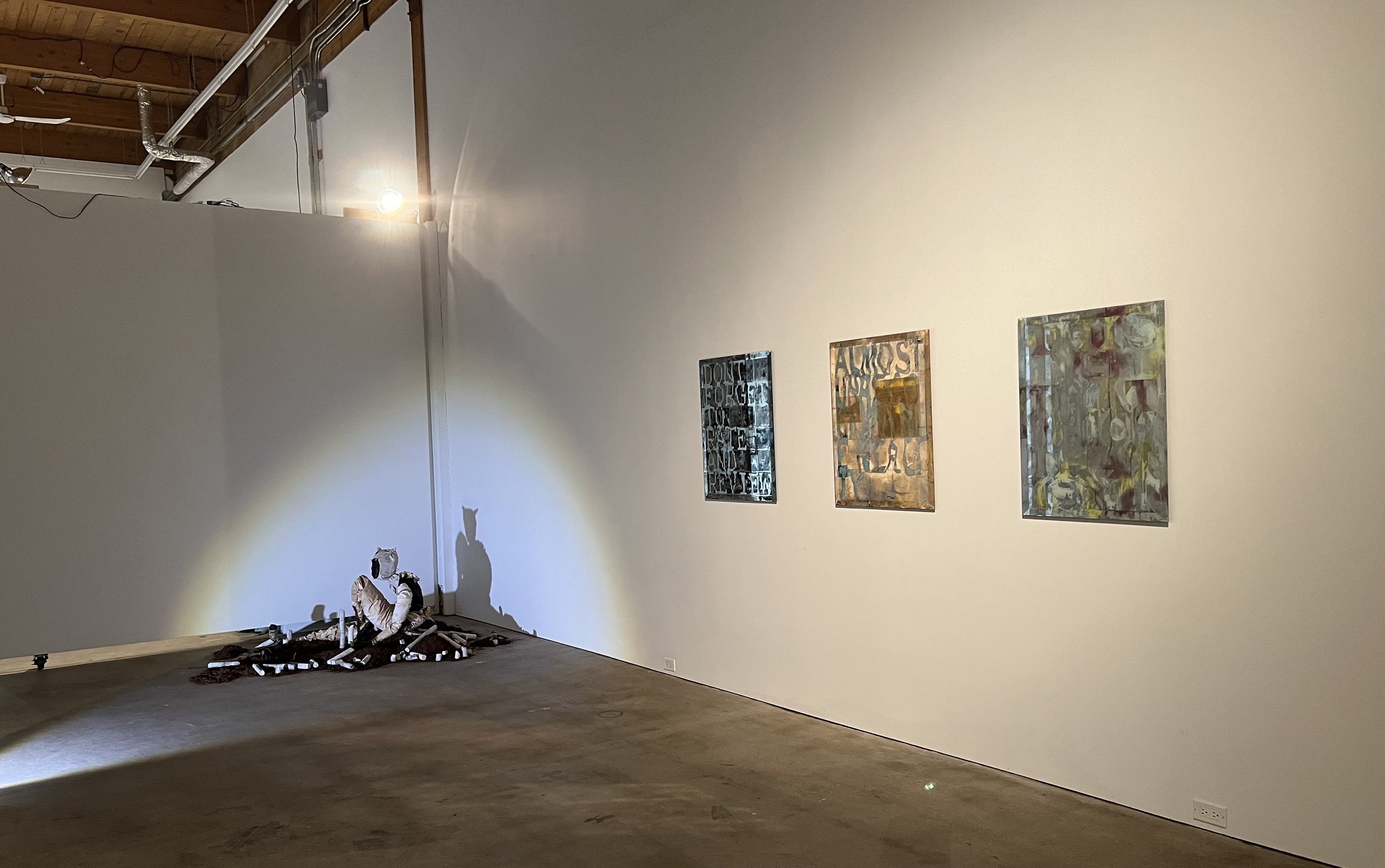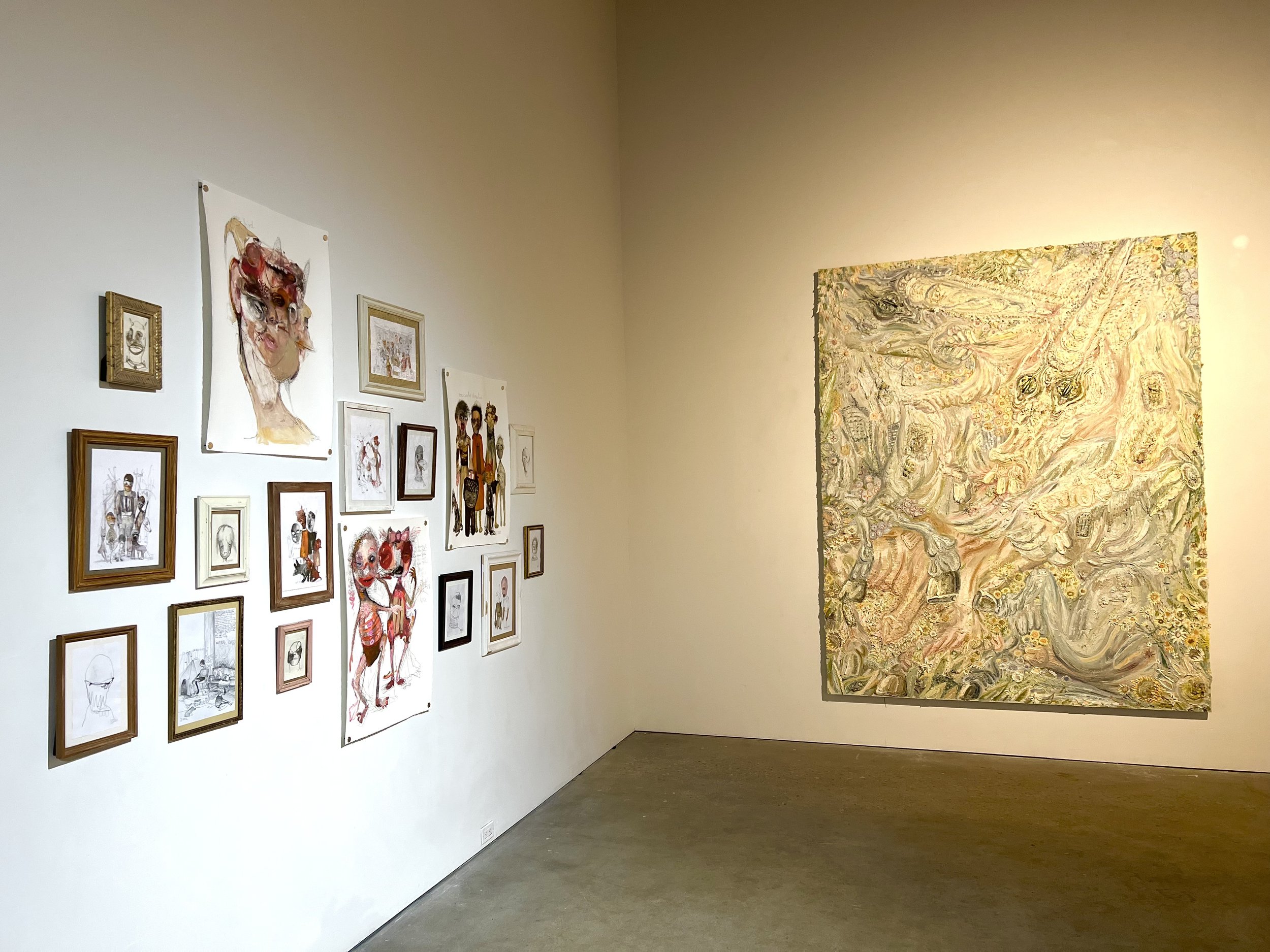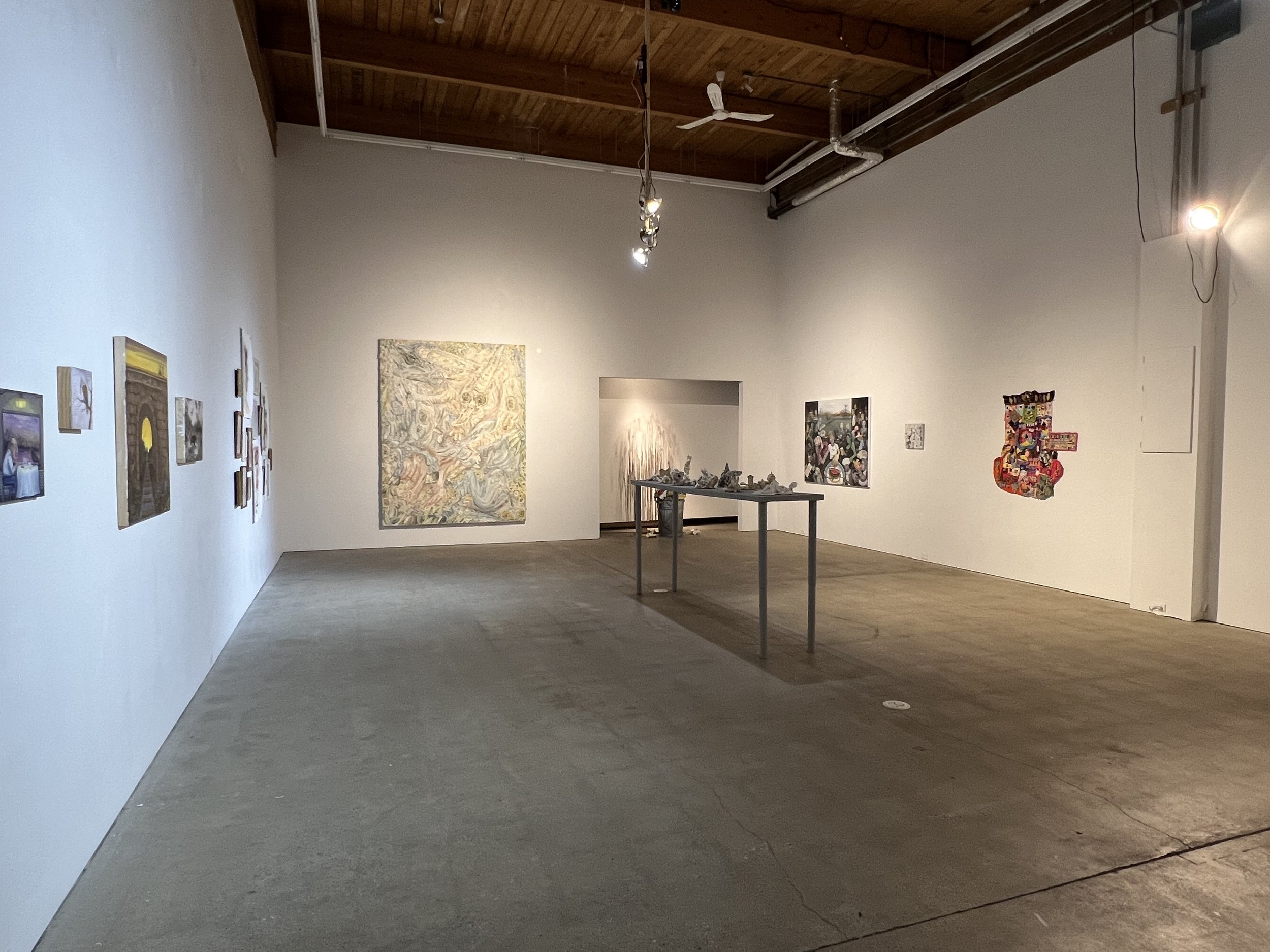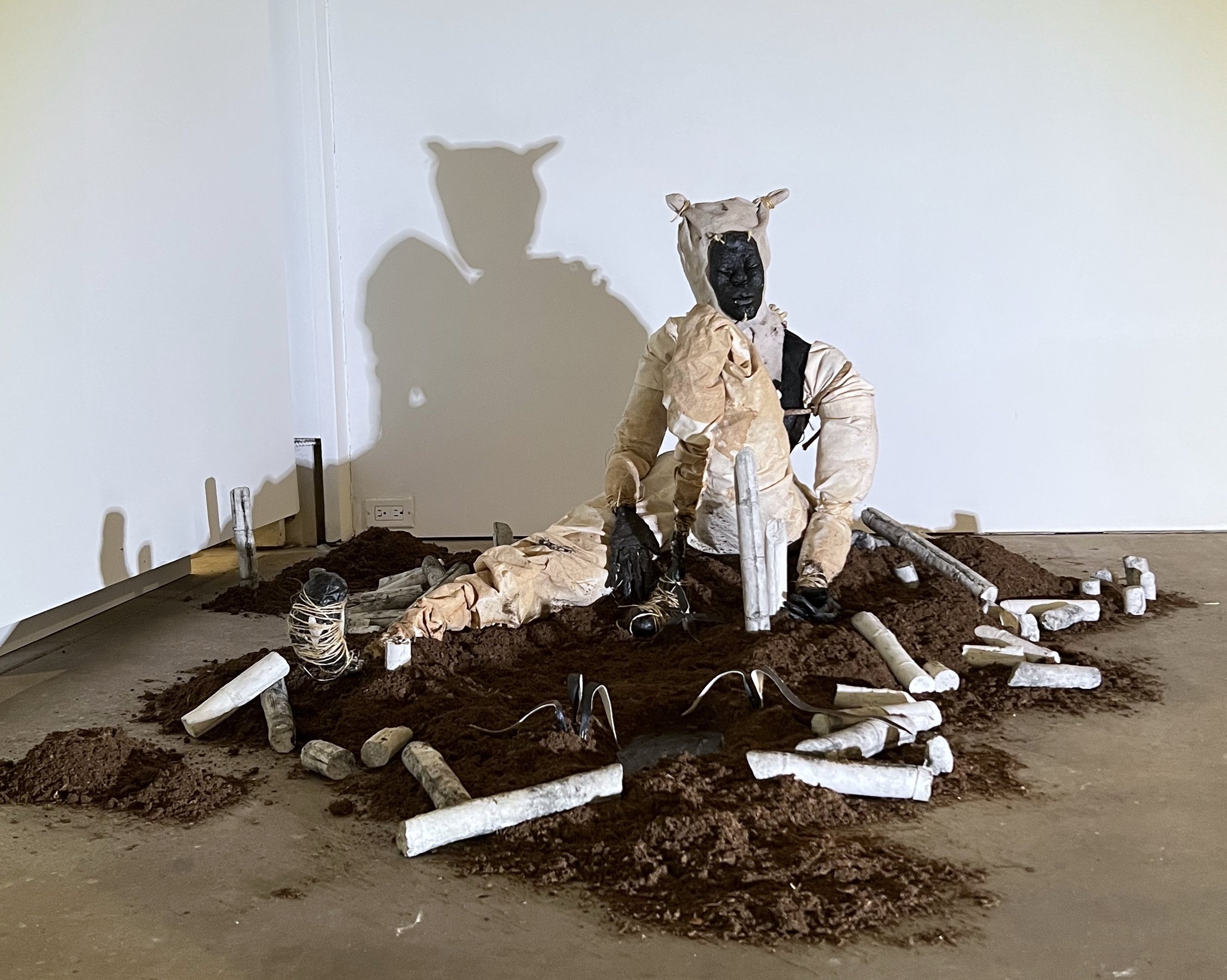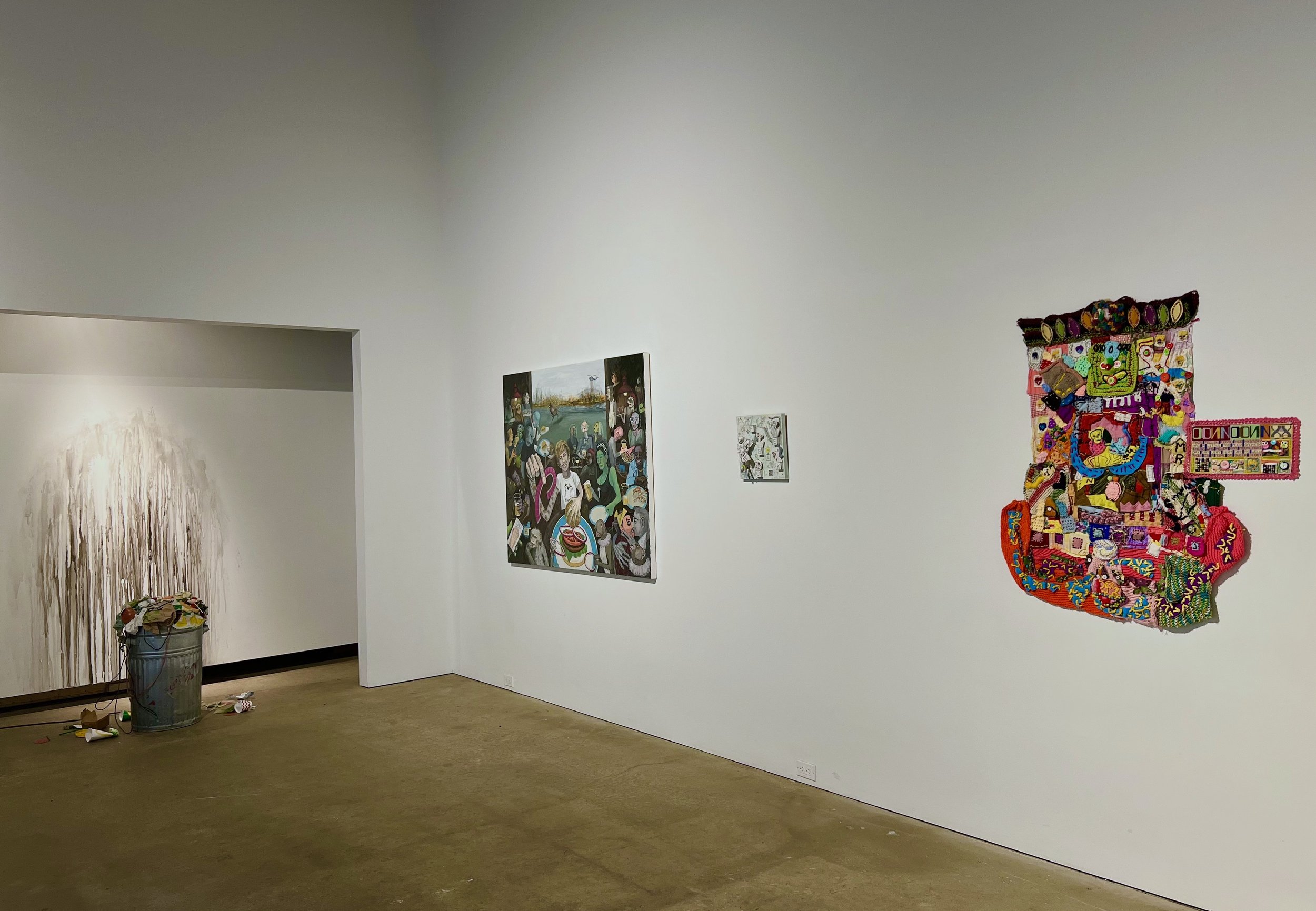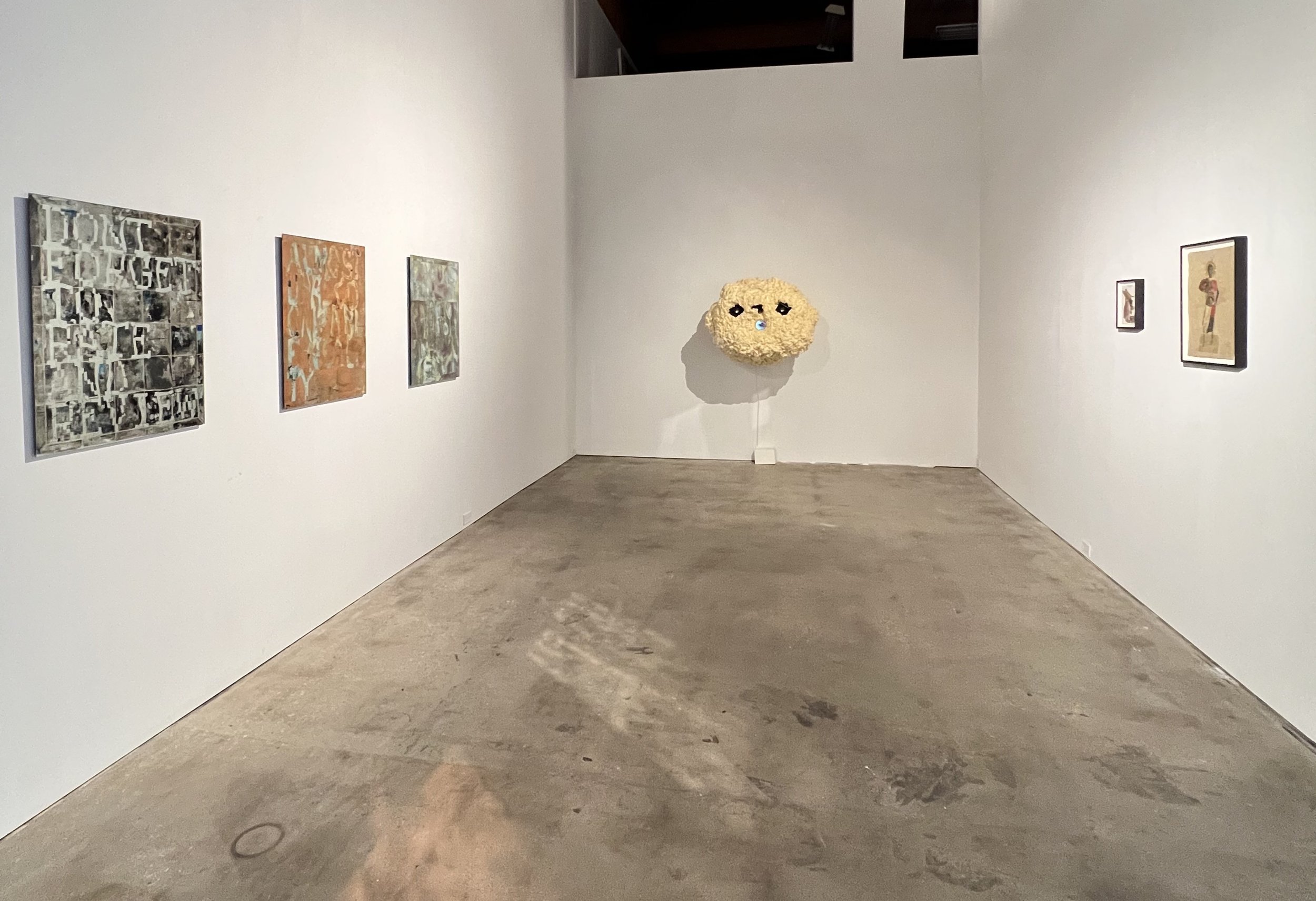Evin Collis. Prizzly, 2016. still from puppet stopmotion animation.
An international group exhibition curated by David Candler
Scrappy - it is material, it is aesthetic, it is attitude, it is an exhibition. And it’s all Jon Pylypchuk’s fault. We’ve all had to be scrappy to keep going recently.
Come see Scrappy as art.
Featuring works by:
Kyle Beal, Richard Boulet, Evin Collis, Violet Costello, Beth Frey, Braxton Garneau, Jude Griebel, Juliane Hundertmark, Jon Pylypchuk, Tammy Salzl, Curtis Talwst Santiago, Allison Schulnik and Fischli & Weiss
Jon Pylypchuck. Maybe Next Year, 2002. printed fabric, faux fur, velour, plastic, acrylic, glitter and paper collage on paper
Curatorial Statement
I’ve had the word “Scrappy” fermenting in my brain for over a decade, following an artist tour with Jon Pylypchuk at his solo exhibition at Musée d’Art Contemporain in Montréal. I had been puzzling over common ways of making at the time; process abstraction (now commonly referred to as zombie formalism) and “sh*t on the floor” (my term) sculptural accumulation were lost on me. I knew there were artists working with scrappy material in a rigorous, thoughtful, and sometimes exquisite way, and others using pristine materials to make things that looked really rough. That was a “scrappy aesthetic” I could feel and value. In addition, the artists I was privileged to know were, nearly all of them, the very definition(s) of scrappy. Thus started a decade+ long cloud of intrusive thoughts about - SCRAPPY.
Scrappy is a term that can imply so many things about art, about us. Pugnacious, feisty, resilient and steadfast, independent, bits and pieces tentatively glued, badly organized or put together, untidy and not very attractive, persistent and combative, surviving against odds. It is a word that aptly describes what the world feels like to me after the past several years, and also describes what we’ve all had to strive to be to get us through the tumult of the present and the questions of the future. All the art presented in this exhibition, coming from artists in Alberta, NY, Barcelona, Berlin, Mexico City, LA, and Munich, is one or many versions of scrappy. I hope this work makes viewers feel something deeply, see some beauty in the imperfect, and feel some joy in their own scrappiness.
David Candler - curator
Kyle Beal. Almost Unrecognizable, 2020. mixed media
Canadian artist, Kyle Beal, challenges convention through his conceptual art practice. Using a multidisciplinary approach, he incorporates a wide variety of media including drawing, sculpture and installation. Images of ubiquitous objects and spaces appear as a common thread throughout his works. The initially apparent simplicity of his subjects, however, is underscored by Beal’s application of optically illusionistic techniques. Engaging audiences with nuanced surprise, humorous tropes, and wit, Beal presents an accessible platform for his viewers to reconsider their day-to-day routines and behaviour. Beal holds a BFA from the Alberta College of Art and Design (2001) and an MFA from the University of Victoria (2004). His work has been exhibited across Canada and the USA in Montreal, Toronto, New York City, Calgary, Saskatoon, Seattle, and Vancouver, notably including presentation in the 2015 Alberta Biennial of Contemporary Art at the Art Gallery of Alberta, Edmonton, and the Esker Foundation, Calgary, among others. Beal currently lives and works in Edmonton, Alberta. Upcoming exhibitions include a Series Exhibition in 2019 at the Nickle Galleries at the University of Calgary. Kyle Beal is represented by VivianeArt in Calgary AB.
Richard Boulet. OONNOONNXX, 2022. mixed textiles
Richard Boulet “I was born and raised in Alberta - Peace River, Whitecourt then Calgary. My family has always been loving and stable. Yes we did have our problems but we have always found a way to work them out. At age 33 I was diagnosed with schizophrenia. The worst of my pre-diagnosis days had me living marginally for 1 ½ years wandering from city to city while self-medicating. I have quite a bit of post-secondary training in art. I earned a MFA at the University of Alberta graduating in 2006. I have been told that empathy is contingent on our willingness to be vulnerable. Talking openly and honestly about our lives goes a long way in reducing the stigma associated with mental health/mental illness. My physical, psychological, and spiritual needs are being met and my problems are few. I believe in social justice as a guiding philosophy. I enjoy a quiet life of simple pleasures.”
Evin Collis is a visual artist and animator from Winnipeg, Manitoba currently working in Barcelona, Catalunya. Through a combination of drawing, painting, comics and animation his work investigates the complexities of the degraded landscape and the human condition. Previous employment as a porter on the Canadian transcontinental railroad has greatly influenced his vision. The work delves into the cultural myths, realities and spectres of history, industrialization, decay, class and the contradictions of progress. He holds an MFA in Painting and Drawing from the School of the Art Institute of Chicago and is presently working on the third instalment of his mute-comic series ‘Litterpig’.
Violet Costello. A You’re Adorable, 2022. mixed media on panel.
Violet Costello is an artist living and working in Calgary, Alberta. Born in Morpeth England in 1957, Costello moved to Canada as a child, studied at the Alberta College of Art and Emily Carr College of Art and Design where she graduated with honours. She graduated with an MFA in sculpture from Montréal’s Concordia University in 1991 and has taught both there and at University of Saskatchewan in Saskatoon.She received the J.W. McConnell Memorial Fellowship upon graduation from Emily Carr and has received awards from Alberta Foundation for the Arts, British Columbia Culture, and Canada Council. Her large-scale sculptural installations have been exhibited throughout Canada. A common thread in much of her work has been consideration of the children’s world of play—a realm where reality readily gives way to, and confuses with, imagination. Her work raises questions about the construction of identity and the nature of representation. It is at once amusing and unsettling.
Beth Frey. Untitled, 2022. still from single channel video.
Beth Frey is a Canadian artist who works with a variety of media, including drawing, painting, video, and sculpture. Through her wry, absurdist sense of humour, Frey playfully draws out contradictions in her subject matter, be it gender, the body, social media, mental health, or spirituality, often integrating representations of herself into her chromatic cartoon-like world. Frey has an MFA in Painting and Drawing from Concordia University and a BFA from the University of Victoria. She has exhibited her work in a number of solo and group shows across Canada, Mexico and the US. Frey currently divides her time between Montreal and Mexico City.
Braxton Garneau. CANNES BRÛLÈES, 2021. multiple media
Braxton Garneau is an emerging visual artist living in Edmonton - Amiskwaciwâskahikan, Canada. He holds a BFA degree from the University of Alberta and a Diploma of Fine Art from Grant MacEwan University. His current practice combines a variety of harvested and hand-processed materials with printmaking, painting, and installation to create portraits, shrines, and corporeal forms. These materials often share inextricable colonial histories and significant cultural ties to those who’ve spent generations in close proximity to them. Exploring the materiality of culture, Garneau mines his own Caribbean heritage to charge his practice with the essences of animism and masquerade that swirl within Trinidad and Tobago. He merges classical aesthetics and double entendre to cultivate a visual language steeped in burlesque and iconoclasm. Garneau’s transformative approach of combining traditional media/subject matter with raw and repurposed material serves to disrupt the historical notion of mastery and to democratize the privilege of viewership. He revisits traditional handicraft to explore the sociocultural history between humans and colonial goods.
Jude Griebel. November Stoop, 2018. Sandblasted and glazed ceramic, 6x6.5x7”
Jude Griebel Using techniques such as carving, modelling, Jude Griebel creates intensively detailed figurative sculptures that visualize our entanglement with the surrounding world. His more developed works are generated from playful studies that do not often see the light of day: crayon drawings on the back of envelopes, plasticine bent into forms that are left to slump in upon themselves. His ceramic works in Scrappy can be viewed as three-dimensional sketches, locked into place through the kiln-firing process. Though their stories could be further developed, these ceramics remain uncomplicated, blithe, and potent in their possibility.
Juliane Hundertmark. Vaccinated Beauties, 2021. Mixed media on paper.
Juliane Hundertmark Juliane Hundertmark paints a humorously serious portrait of humanity, using visual metaphors to convey meanings and ideas. Ghostly ‘unfinished’ figures appear beside ‘solid’ figures, like messengers from another dimension. Hundertmark’s work is energetic but orderly. Warm colour is diffused through layers of underpainting, adding to the supernatural atmosphere. Hundertmark was born in Mainz in 1971 and lives in Berlin, Germany. She studied design and stage design at the University of Bayreuth and has a master’s degree from the Academy of Fine Arts Nuremberg. She won Kunstverein Bayreuth’s prize for young art in 2004. Hundertmark is presented in collaboration with Knight Webb Gallery, London UK.
Tammy Salzl. Self (Shame), 2018. multiple media, video and sound.
Tammy Salzl is a Canadian multi media artist who completed her Master of Fine Arts at Concordia University in 2014. Salzl’s work is driven by her interest in the power of storytelling and the connections she sees between the human psyche, identity, and humankind’s relationship with the natural world. She has presented her work across Canada as well as internationally, and has received several grants and awards. Salzl’s borrows from a myriad of sources including: ecology, feminist theories, surrealism, traditional fairy tales, and Greek mythologies to create psychological portraits that embody our shifting sense of self in these complex times.
Curtis Talwst Santiago. Pope Jahmal (detail), 2019. mixed media collage.
Curtis Talwst Santiago studied as an apprentice of Lawrence Paul Yuxweluptun. Santiago has exhibited internationally at venues such as The Drawing Center, New York, NY; The FLAG Art Foundation, New York, NY; The New Museum, New York, NY; The Eli and Edythe Broad Museum at Michigan State University, East Lansing, MI; the Institute of Contemporary Art at Virginia Commonwealth University, Richmond, VA; the University of Saskatchewan, Saskatchewan, Canada; The Pérez Art Museum Miami, Miami, FL; Art Gallery of Ontario, Toronto, Canada; Art Gallery of Alberta, Edmonton, Canada; Osage Gallery, Hong Kong and the SCAD Museum of Art, Savannah, GA; among others. The artist was included in the inaugural 2019 Toronto Biennial of Art in Toronto, Canada, the SITE Santa Fe SITELines.2018 Biennial, Casa Tomada, in Santa Fe, NM, was featured in the 2018 Biennale de Dakar in Dakar, Senegal and in September 2021, he was an Artist in Residence at Kehinde Wiley's Black Rock Senegal. He is currently an active board member on the Board of Directors for the Drawing Center in New York and a visiting professor and Artist in Residence at the University of Tennessee, Knoxville until May 2022. His works are in multiple permanent museum collections. Santiago considers himself decentralized and is currently living and working in Munich, Germany. Santiago is represented by Rachel Uffner Gallery NYC
Allison Schulnik. Two Long Unicorns (detail), 2016. oil on linen. 100 x 78”
Working in paint, sculpture, and animation, Allison Schulnik seamlessly transitions between mediums, imbuing her work with a distinct sensibility that melds theatricality with intense emotional vulnerability. Known for her uncanny approach to traversing the internal and immaterial terrains of nostalgia, childhood memories, and dreams, Schulnik choreographs an honest, complex and contemporary portrait of new motherhood and life seen through the red haze and black silence of the desert. Schulnik lives and works in Sky Valley, CA. Solo exhibitions of Schulnik’s work have been presented at the SCAD Museum of Art, Savannah, GA; Wadsworth Atheneum Museum of Art, Hartford, CT; Laguna Art Museum, Laguna Beach, CA; Oklahoma City Museum of Art, OK; Nerman Museum of Contemporary Art, Overland Park, KS; Mark Moore Gallery, Los Angeles; ZieherSmith, New York, NY; and Galeria Javier Lopez & Fer Frances, Madrid. Schulnik’s work can be found in numerous museum collections including the Los Angeles County Museum of Art, Los Angeles, CA; Museum of Contemporary Art San Diego, CA; Santa Barbara Art Museum, Santa Barbara, CA; Museé de Beaux Arts, Montreal, Canada; Laguna Art Museum, Laguna, CA; The Crocker Art Museum, Sacramento, CA; Wadsworth Atheneum Museum of Art, Hartford, CT; and The Albright-Knox Gallery, Buffalo, NY. Purple Mountain, Schulnik’s second solo exhibition with the gallery will open in November 2022. Schulnik is represented by P.P.O.W Gallery in NY and Nino Meier Gallery in Los Angeles.
Peter Fischli and David Weiss. The Way Things Go, 1987. still from single channel video.
Swiss artists Peter Fischli and David Weiss were born in Zürich in 1952 and 1946, respectively. Fischli graduated from the Academia di Belle Arti, Bologna in 1977 and Weiss from the Kunstgewerbeschule, Zürich in 1964. The artists established a collaborative partnership in the late 1970s. Their humorous and playful works, in a wide variety of mediums such as photography, sculpture, installation and video, challenge traditional notions of the art object and the artist himself. Throughout their oeuvre, everyday objects and experiences are removed from their traditional contexts and transformed into something new, becoming involved in alternative narratives that emphasize the subjective nature of art and the art object. In their work, irony and contradiction are often present and things are not always what they seem. Fischli and Weiss are best known for the film The Way Things Go (1987), in which everyday household and art studio objects interact with each other in implausible, humorous scenarios.
